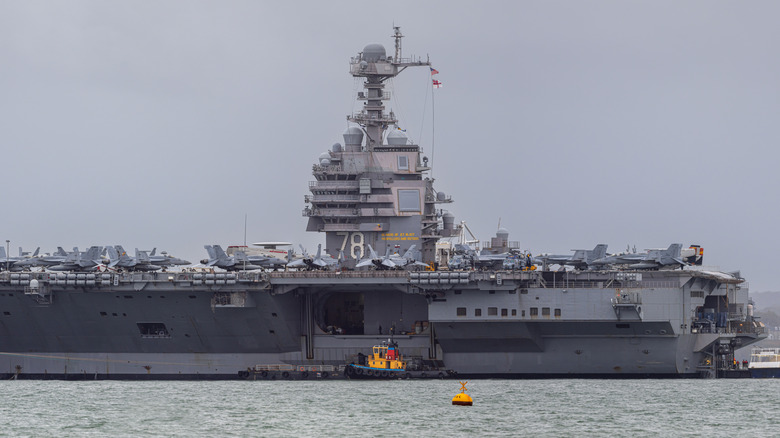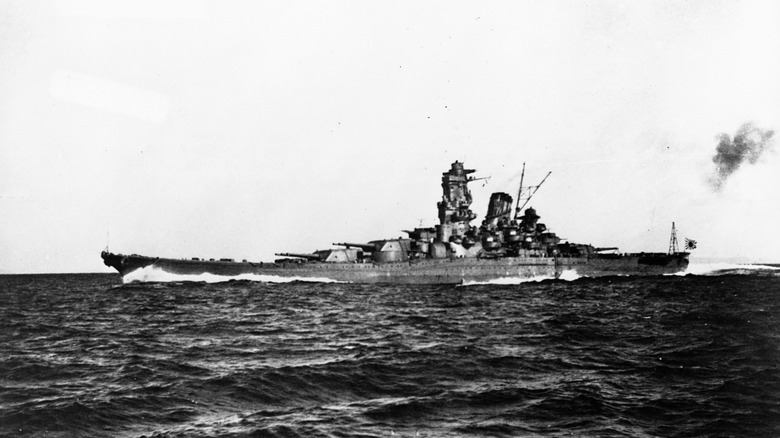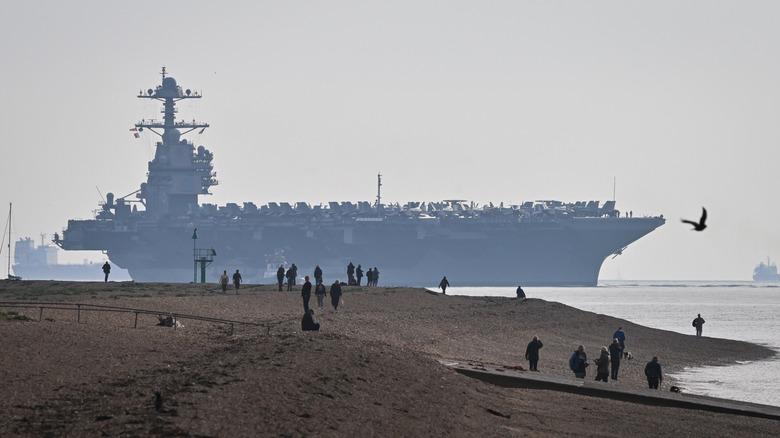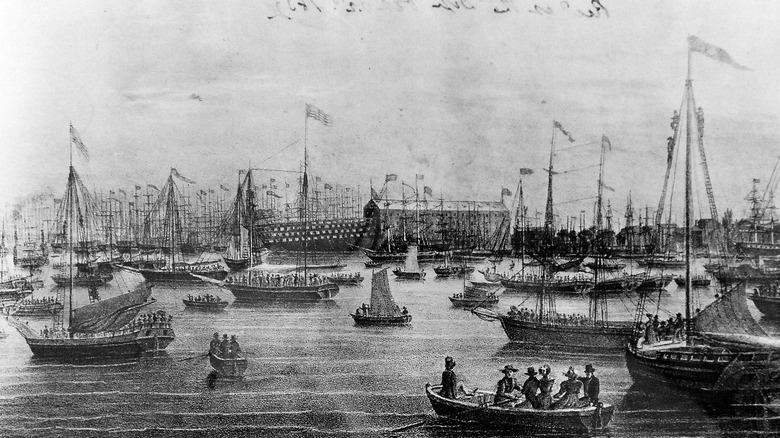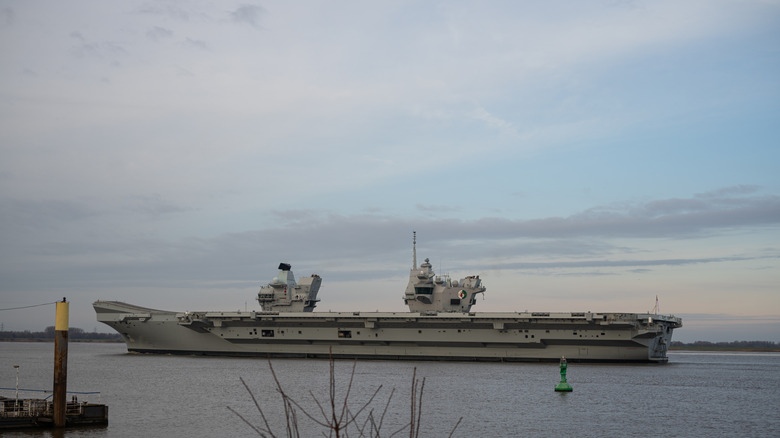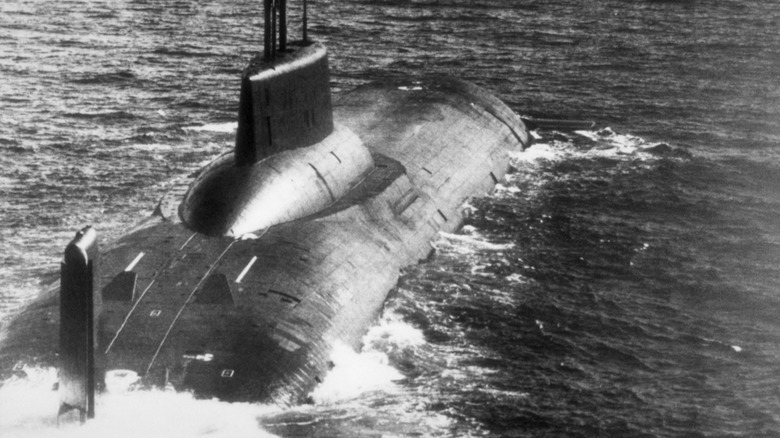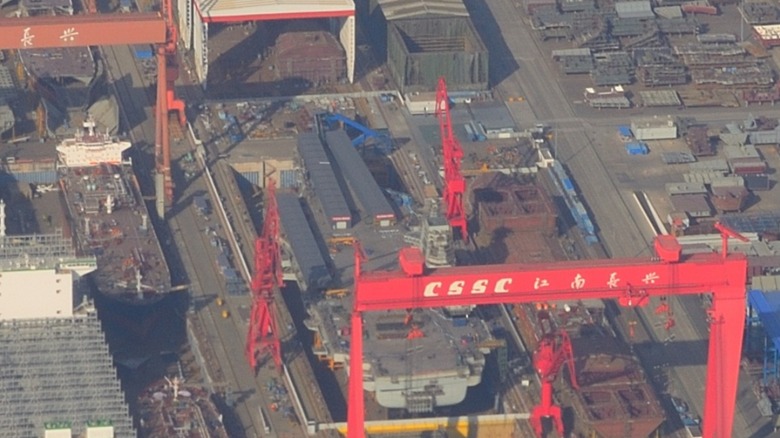6 Of The Largest Warships In Military History
Combat on the ground and in the air has changed dramatically, over the centuries. The earliest tanks and planes may seem laughably primitive today. The same goes, of course, for naval combat and the development of warships.
These vessels come in all kinds of shapes and sizes. Today's warships run the gamut from gigantic aircraft carriers to small corvettes, which are crewed by just five people. In January 2024, the Royal Navy's Commander, Richard Skelton, spoke of the Coastal Squadron's "clear intent to return to our roots and once again become experts in small boat warfare," but the grandeur and sheer intimidation of their more sizable counterparts is unrivaled.
To celebrate these vessels, ships of a scope that would cause even Royal Caribbean to raise a collective eyebrow, let's take a closer look at some of the biggest warships ever constructed. From the U.S.S. Gerald Ford – all 100,000 tons of it – to Japan's monstrous Yamato, World War II's most formidable battleship, there's a lot of ground to cover. This will be a wild ride through some of the mightiest seafaring weaponry engineers have ever created. Not to mention the gigantic literal weapons that the ships themselves are armed with, of course. We'll be considering the relative size of different types of warships too, from the biggest aircraft carriers ever built, to the largest ships that slide beneath the waves.
The Yamato
On land, World War I saw the birth of the tank, the Mark I fielded by the British in France in September 1916. Almost three decades later, during World War II, Germany introduced the Messerschmitt Me 262A, history's first jet fighter used in conflict. Meanwhile, in the ocean, the Japanese would unleash something perhaps just as astonishing: the Yamato battleship.
Japan was a co-signatory of 1922's Five-Power Naval Limitation Treaty, which (among other things) forbade construction of battleships with guns larger than "16 and/or with a displacement of greater than 35,000 tons. This was a temporary measure, though, and when it was through, the Japanese set about creating a vessel that far exceeded these limitations. The Yamato had a displacement of twice that previous limit, with a maximum displacement of approximately 72,809 tons. It was 263 meters long and up to 38.9 meters wide.
Yamato, which had an equally enormous sister battleship in the Musashi, took almost seven years to finish. Finally arriving in December 1941, its fearsome weaponry included the biggest gun ever mounted on a ship of its kind, the Type 94. There were nine of them, for good measure.
Bigger doesn't always mean better, though. Ultimately, Yamato had very little time to use all that firepower: It saw action just once before was lost on April 11, 1945, sunk by U.S. aerial assaults with over 3,000 crew members believed to have died in the attack and the sinking.
The USS Gerald Ford
The tradition of U.S. navy ships named after presidents dates back to George Washington himself, but only a select few holders of the office currently have the honor of having the world's largest warship named for them. USS John F. Kennedy joins the USS Gerald R. Ford in the latter's namesake class. The USS Gerald Ford is an aircraft carrier that was commissioned by the US Navy in 2017. Though carriers are known for their great size, this one absolutely takes that ball and runs with it.
This supercarrier is the biggest vessel of its kind, and is the overall largest warship in the world. Needless to say, it's also a very different type of ship to a battleship like Japan's Yamato. Carriers are so big because they need the capacity to transport aircraft, as well as allow for their safe take-off and landing – which requires colossal space for some models – in tandem with the other operations such a vessel has to be privy to.
This super cruiser class accommodates up to 90 aircraft, and to help it do so, it has a majestic frame of almost 41 meters wide (beam) and 333 meters long. This developing line of vessels seems poised to excel in capacity as well as sheer mind-boggling dimensions, with almost two dozen system additions and improvements that set it apart from the similarly (but not equally) sizable Nimitiz line.
USS Pennsylvania
A ship the size of an aircraft carrier, naturally, needs an enormous amount of power. This power is typically provided by nuclear reactors, the action of which produces heat, leading to steam that turns the ship's supersized turbines. For centuries, though, a ship's main means of propulsion was the sail.
Indeed, the Pennsylvania is history's biggest sail-powered warship, with a crew of 1,100 and three gun decks. Construction began in 1822 and the ship was finally commissioned in 1837. It's little wonder that it was such an involved project: this gargantuan sailing ship was 223 feet seven inches long, with a hull weight of 2,696 tons. Needless to say, it was also very heavily armed. Its arsenal included around 130 guns, including 32-pound guns and Paixhans guns.
This powerhouse sailing ship was a ship of the line, some of the biggest and most powerful vessels of their time, which would turn and face their counterparts in an opposing line of battle and blast away.
In the U.S. Naval Institute's "The Ships of the Line of the Old Navy," in 1938, former U.S. Naval Academy assistant librarian Louis H. Bolander dubbed Pennsylvania "our most ambitious bid for naval supremacy." It would travel the ocean only once, before being destroyed at the Norfolk Navy Yard in April 1861 to prevent the encroaching Confederate army from claiming it.
HMS Queen Elizabeth
The United States isn't the only nation to boast vast aircraft carriers, of course. The British Royal Navy has a centuries-long reputation for both its size and its power, and this can only be maintained by remaining at the cutting edge of military technology. No vessels of the U.K. fleet express this sentiment quite like HMS Queen Elizabeth.
This vessel has a crucial historical legacy. Its predecessor, Queen Elizabeth — named in honor of the last of the Tudors — was the setting for the German surrender at the close of World War I. In 2017, commissioning of the new HMS Queen Elizabeth was completed, and it's an awe-inspiring vessel indeed: It has a four-acre flight deck, and though its 40-aircraft capacity doesn't top that of the U.S. Navy's USS Gerald Ford, it's still a titan of a carrier. The Queen Elizabeth is approximately 931 feet long and has a displacement of 65,000 tonnes.
It's equipped with a Vulcan cannon, the Phalanx weapon system, and the advanced Artisan 3D radar system, but it's far from just a weapon: It also has such potent water purification capabilities that 500 tons of fresh, drinkable water can be produced on the vessel in just a single day. The other of the two current vessels in the Queen Elizabeth class is, naturally, the HMS Prince of Wales. The late royal couple remains inseparable, it would seem.
The Typhoon Submarine
Though warships primarily float on the ocean, the submarine was designed to plumb its depths. The Soviet Union developed some fearsome weapons in its time, and some of the most fascinating are those that ventured into rather unknown, ludicrously gigantic technology. In the realm of naval warfare, the Typhoon class of submarines absolutely qualify.
Six Typhoon-class submarines were built by the Soviet Union, first introduced in December 1981, and their dimensions speak for themselves. At 574 feet long and up to 75 feet wide, they can accommodate around 150 crew members. They can also achieve a speed of up to 27 knots, powered by a pair of nuclear reactors.
The prevailing image of a submarine may be of a tight fit in a cramped space, but the dimensions of a vessel like this ensures that wouldn't be the case here. Not if the sauna and swimming pool it boasted are anything to go by.
Built during the 1980s, the submarines in this class were sophisticated models, constructed with numerous inner hulls within its main body and with some limited soundproofing to support the structure on dives down to depths of around 400 meters. These Severodvinsk Shipyard creations also had advanced threat detection capacity and sonar, as well as formidable weaponry including RSM-52 intercontinental missiles.
The last of these submarines, which were designed for longer journeys in the depths, was decommissioned in 2024.
The Fujian aircraft carrier
China's navy, in terms of the number of warships available to it, is the biggest on the planet. The People's Liberation Army Navy has vessels that are, on average, smaller than those in the U.S. repertoire. In April 2022, Forbes estimated that the ships available to China may weigh a total of around 2 million tons., compared to 4.5 million tons worth of U.S. Navy ships. This isn't to say, of course, that China doesn't field some absolute ocean-going titans such as its aircraft carrier, the Fujian.
China hadn't designed and built an aircraft on home soil/water before this mighty model, and when it decided to do so, it pulled out all the stops. The 80,000 ton super-carrier, a first for the nation, completed testing in ocean conditions in May 2024, and it was plain from early in the construction process that the model would be grand in scope and capability. "This will be the largest and most advanced aircraft carrier ever built outside the United States," Robert Farley reported in The Diplomat in May 2019.
The third of China's carriers is set to be a power to be reckoned with, estimated to be about 315 meters long and equipped with launchers powered by electromagnets. These could be utilized by the upcoming J-35 fighter, a secretive stealth model.
